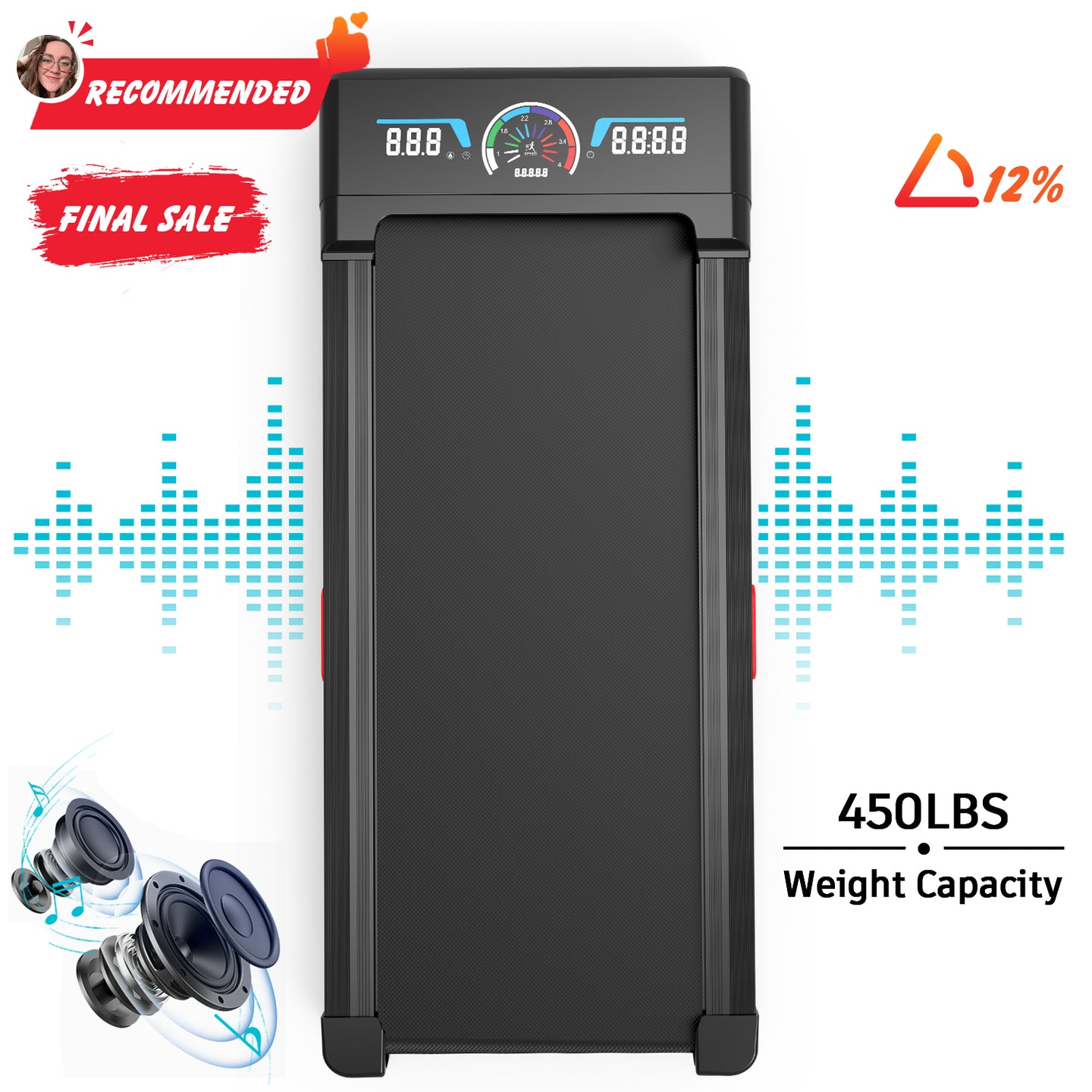How Much Calories Does Running Burn

Don’t forget to check out our Pacerocker, Trailviber, and Trailviber Auto Incline walking pad treadmills.
Running is a great way to boost our fitness levels and shed some extra pounds. It doesn't just help in improving our cardiovascular health; it also burns plenty of calories. Running can burn approximately 100 calories per mile for an average person. This simple fact can be a big motivator for those looking to manage their weight or improve their health.
The number of calories burned while running depends on several factors, including our weight, speed, and running duration. A heavier person generally burns more calories than a lighter one because they have a higher energy expenditure due to their body mass. Similarly, running faster or for a longer duration increases the total calorie burn.
Let's remember that knowing how many calories we're burning can help us set realistic goals. By combining running with proper nutrition and hydration, we can optimize our running sessions for better results. It's always exciting to see how small changes in our routine can lead to significant improvements in our fitness journey.
Key Takeaways
- Running burns approximately 100 calories per mile for an average person.
- Factors like weight, speed, and duration affect calorie burn.
- Proper nutrition and hydration enhance running performance.
The Basics of Calorie Burning
When we run, our bodies burn calories by using energy. This depends on different factors, such as our weight and the level of effort. We measure energy use in METs, which help us estimate calorie burn.
Understanding Calories and Energy Expenditure
Calories are units of energy that fuel our activities. Our bodies use them for everything from breathing to running marathons. Each activity demands different energy levels.
Energy expenditure refers to the energy we use in a day. This includes the energy for daily functions and exercise. Running increases energy expenditure significantly compared to resting or light activities. Knowing how many calories we burn can help us manage our weight and fitness goals more effectively.
The Role of MET in Estimating Calorie Burn
MET stands for Metabolic Equivalent of Task. It's a way of measuring the energy cost of physical activities. A MET value of 1 represents the energy used when resting. Running usually has a higher MET value, meaning it burns more calories.
By multiplying the MET value of an activity by our weight in kilograms and the duration, we can estimate the calories we burn. This simple formula makes it easier to track how effectively we burn calories during a run. This can guide us in adjusting our workouts for better health outcomes.
Factors Affecting Calorie Burn During Running
When we run, several factors determine how many calories we burn. These include our body composition and weight, how fast and far we go, the terrain and incline we tackle, the temperature outside, and our age and sex. Each plays its own role in shaping our caloric burn.
Influence of Body Composition and Weight
Our body composition significantly impacts the calories we burn. If we weigh more or have higher body mass, we tend to burn more calories. This is because heavier bodies require more energy to move.
Body composition—the balance of fat and muscle—also matters. Muscle tissue burns more calories than fat at rest. This means people with more muscle mass could burn calories at a higher rate, even when not active. So, both weight and muscle are key when considering energy expenditure during running.
Impact of Running Speed and Distance
Running speed is a straightforward factor in how we burn calories. The faster we run, the more energy or calories we use per mile.
Distance adds another layer to this. Longer distances can mean more calories burned overall, even if run at a slower pace. We might run slow for a long time or fast for a short burst, but both ways can effectively burn calories. It’s up to our goals and comfort levels to decide which is best for us.
Effect of Running Terrain and Incline
The terrain we choose can change everything about our run. Running on flat ground might be easy, but hills make us work harder.
An incline, like a hill, increases calorie burn because our muscles exert more effort to climb. Even a small incline can boost our workout’s calorie expenditure. Trail running with uneven surfaces requires our lower bodies to stabilize with each step, demanding more energy. So, more challenging terrains push us to burn more.
Temperature and Running Efficiency
Temperature can be a surprising factor in running efficiency. When it's hot, our bodies use extra energy to cool down, which might increase our calorie burn.
In contrast, running in the cold also ramps up energy needs to keep our bodies warm. Both extremes demand more from us, influencing the calories burned. It’s essential to adjust intensity according to comfort and safety while keeping in mind how the weather might be affecting our energy use.
Significance of Age and Sex on Caloric Expenditure
Age influences how our bodies handle activity. As we get older, muscle mass can decrease, potentially lowering our calorie burn unless we actively maintain it.
Sex differences also come into play. Generally, men might burn more calories than women due to differences in muscle mass and size. However, every individual is unique, and factors like fitness level and body composition_mean it can vary. Keeping active can help us counter these influences over time.
Calculating Calories Burned Running
When it comes to knowing how many calories we burn while running, there are easy ways to figure it out. We use different tools and formulas to help us get a good estimate based on our pace and running time.
How to Use a Running Calorie Calculator
A running calorie calculator gives us a quick way to find out how many calories we burn. We just need to enter a few details, like our weight, running distance, and speed. Many online calculators are free and easy to use. Some ask for extra information, like age or gender, to make calculations more accurate.
We can often find options to select if we ran on flat ground or hills. Select the right terrain to get a better estimate. Using these tools, we get a clear idea of our calorie burn.
Formulas and Tools to Estimate Calories Burned
There are several formulas to estimate calories burned while running. A common one is to multiply our weight in pounds by the distance run in miles. On average, a person burns about 100 calories per mile run. This can vary based on speed and body composition.
Some advanced calculators use the MET (Metabolic Equivalent of Task) method. It considers our pace in minutes per mile and other factors. Using these tools helps us make more informed decisions about our workouts and track our progress.
Running for Weight Management
Running helps us manage weight by burning calories, creating a calorie deficit. When paired with a balanced diet, it becomes even more effective for weight loss. Let’s dive into how running fits into our weight management goals.
Creating a Calorie Deficit Through Running
To lose weight, we need to burn more calories than we consume. Running is an excellent way to achieve this. It burns a high number of calories compared to other exercises.
For instance, a person weighing 155 pounds can burn about 372 calories by running at 6 miles per hour for 30 minutes. This calorie burn helps in creating a deficit, which is crucial for weight loss. Consistency is key; regular runs contribute significantly to our fitness journey. Tracking our runs and calorie intake can guide us in achieving our goals efficiently.
Incorporating varying speeds, such as intervals, can enhance calorie-burning effects. Running uphill or using inclines can also increase the intensity, boosting our overall calorie burn.
Combining Diet and Running for Weight Loss
While running helps burn calories, combining it with a healthy diet optimizes our weight loss efforts. Eating a balanced diet rich in nutrients supports our energy levels for longer runs.
We should focus on whole foods like fruits, vegetables, lean proteins, and whole grains. These provide the fuel needed for workouts while keeping us full, preventing excess calorie intake.
Monitoring portion sizes and avoiding processed foods can further aid our objectives. Hydration is important too, as staying well-hydrated enhances our performance and aids in recovery. By aligning our diet with our running routine, we increase our chances of achieving and maintaining our desired weight.
Advanced Considerations in Running
Running is not just about distance and speed. Factors such as terrain, intensity, and recovery can affect how many calories we burn. By analyzing these aspects, we can maximize our workouts and achieve our fitness goals.
Running Uphill vs. Downhill
When we run uphill, our bodies work harder. Muscle engagement increases as we push against gravity, boosting calorie burn. Uphill running strengthens our quads, calves, and glutes. It's like doing a resistance workout.
Conversely, running downhill might seem easier, but it has its own benefits. We use different muscles—mainly our quadriceps—as we control our descent. Though it burns fewer calories, it emphasizes control and balance. It's crucial to maintain good form to avoid injury.
Choosing between uphill and downhill running lets us target different muscles. A mix of both can lead to well-rounded fitness.
The Effects of Intensity and Heart Rate
We all know that intensity impacts calorie burn. Higher intensity workouts elevate our heart rate, meaning we burn more calories. For instance, running at a fast pace requires more effort, demanding increased oxygen flow to our muscles.
By monitoring our heart rate, we ensure we're working out at the right level. Target heart rate zones help us optimize our calorie burn without overexerting ourselves. Zones are generally calculated based on a percentage of our maximum heart rate.
Tracking intensity helps us balance challenging efforts with manageable workouts, preventing burnout while improving endurance and strength.
Recovery and Its Impact on Calorie Burn
While running can be intense, recovery plays a key role. It's a time when our bodies repair, getting stronger and more efficient. Surprisingly, recovery can also impact calorie burn. Our bodies continue to use energy as they repair muscles, a process called EPOC (Excess Post-Exercise Oxygen Consumption).
To support recovery, we should focus on nutrition and rest. Eating protein helps muscle repair, while stretching prevents stiffness. Proper recovery ensures that we maintain our performance levels for future runs.
Recovery isn't just rest; it's an active part of our calorie-burning cycle.
Jogging Compared to Sprinting
Jogging and sprinting vary greatly in terms of intensity and calorie burn. Sprinting is all-out, high-intensity training. It burns calories fast and can quickly improve cardiovascular health and muscle strength. The demand for energy skyrockets, making it a powerful exercise.
Jogging, on the other hand, is more sustainable. It allows for longer durations, making it ideal for stamina building. We burn calories steadily over time, benefiting cardiovascular health without the intense muscular demand of sprinting.
Each has its place in a balanced running routine. By mixing both, we engage in comprehensive workouts that build endurance and strength while burning calories effectively.
Nutrition and Hydration for Runners
Fueling our bodies right is crucial for any runner aiming to maintain energy and recover efficiently. Eating enough carbohydrates and staying hydrated are key to supporting our runs and enhancing our performance.
The Importance of Carbohydrates and Muscle Mass
Carbohydrates are our main source of energy. When we run, our muscles use glycogen, which is stored carbohydrates, as fuel. Eating carbs before, during, and after workouts helps keep our glycogen levels high, preventing fatigue.
Foods rich in carbohydrates include whole grains, fruits, and vegetables. These foods also provide vitamins and minerals. Additionally, maintaining muscle mass is essential for improving performance and preventing injury. Protein is important for muscle growth and repair. We should consider meals that include both protein and carbohydrates for effective recovery.
Hydration and Metabolism
Staying hydrated is vital for runners. Water regulates body temperature and helps transport nutrients through our body. Dehydration can lead to decreased performance and increased risk of heat-related issues.
Drinking water before, during, and after runs is important. Sports drinks with electrolytes are beneficial during long or intense runs. Electrolytes, like sodium and potassium, help balance fluids in our body. Proper hydration also supports metabolism, allowing our body to use nutrients more effectively and keeping energy levels stable. Keeping hydrated supports our exercise goals and overall health.
Improving Running Performance
To enhance our running performance, we should focus on improving running economy and incorporating interval training. These techniques can increase calorie burn effectively and help us become better runners.
Enhancing Running Economy and Efficiency
Running economy is about using less energy to maintain a steady pace. To improve it, we can concentrate on our form and breathing. Maintaining good posture reduces unnecessary energy expenditure. We keep our shoulders relaxed and core engaged.
Increasing cadence, or steps per minute, can make a big difference. Most elite runners have a cadence of around 180 steps per minute. Gradually increasing ours can lead to better performance.
Strength training also plays a role. Building strong leg muscles helps us run more efficiently by improving power and stability. Simple exercises like squats and lunges can support our running economy. Including these in our routine can help us run faster without getting tired quickly.
Interval Training and Caloric Expenditure
Interval training involves alternating short bursts of high-intensity running with slower recovery periods. This method burns more calories compared to steady-paced running. It enhances both aerobic and anaerobic fitness, making us stronger and faster runners.
For instance, we can try a 2:1 ratio: run fast for two minutes, then recover for one minute. Repeat this pattern a few times during our workout. These intervals increase our metabolic equivalent of task (METs), boosting calorie burn post-exercise.
Interval training is adaptable. Whether we're beginners or at an advanced fitness level, we can adjust the intensity and duration to suit our needs. Mixing in intervals keeps our workouts exciting and helps elevate our running game.
Frequently Asked Questions
Running is a great way to burn calories. Different factors affect how many calories we can burn, such as speed, time, and distance. Let's look into some common questions about calorie burn during running.
What is the calorie burn per minute while running?
The number of calories burned per minute while running depends on age, weight, and speed. Typically, we can burn between 10 to 15 calories per minute at a moderate pace.
How many calories can I expect to burn by running for half an hour?
For a 30-minute run, we might burn between 300 to 450 calories. This depends on running speed and other personal factors like weight.
What duration of running is required to burn 1,000 calories?
To burn 1,000 calories, we may need to run for about 90 minutes to 2 hours at a moderate pace. Faster speeds can reduce the time needed.
Can you estimate the calories burned when jogging for a distance of 1 kilometer?
Jogging 1 kilometer can burn about 60 to 70 calories, depending on our weight and pace.
Is a 300 calorie burn from running considered effective for weight loss?
Burning 300 calories is a nice addition to a weight loss plan. It boosts our daily calorie deficit when combined with a healthy diet.
What's the difference in calories burned between running and walking 10,000 steps?
Running usually burns more calories than walking. Walking 10,000 steps might burn around 400-500 calories, while running the same number of steps burns more, thanks to the higher intensity.
Discover how running burns calories and how factors like weight, speed, and duration enhance your workout for optimal health and weight management.







